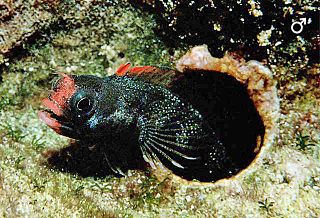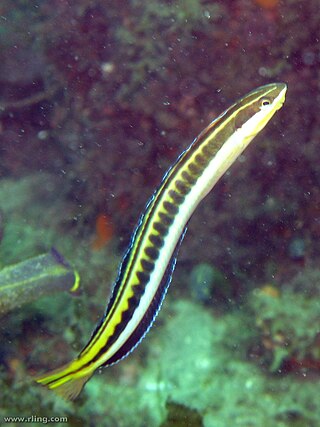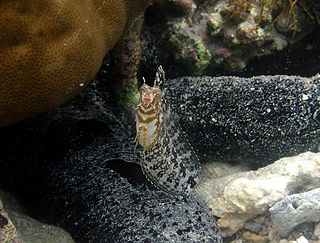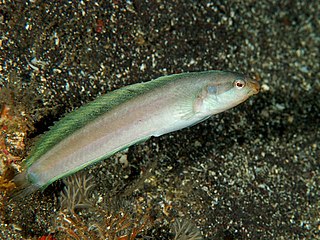
Combtooth blennies are blenniiformids; percomorph marine fish of the family Blenniidae, part of the order Blenniiformes. They are the largest family of blennies with around 401 known species in 58 genera. Combtooth blennies are found in tropical and subtropical waters in the Atlantic, Pacific and Indian Oceans; some species are also found in brackish and even freshwater environments.

Ecsenius is a large genus of fish in the family Blenniidae. Several species, including Ecsenius midas, the Midas blenny, and Ecsenius bicolor, the bicolor blenny, are commonly sold at aquarium stores as pets.

Acanthemblemaria is a genus of chaenopsid blennies native to the Atlantic and Pacific Oceans.

The molly miller is a species of marine ray-finned fish belonging to the family Blenniidae, the combtooth blennies. This species is found in the Atlantic, Mediterranean, and northwest Pacific Oceans. Its colour is a mottled tan, white, and black covering the body and fins. The head of this fish is covered with short hair-like appendages and has two very large eyes. This species reaches 12 cm (4.7 in) in total length.

Plagiotremus is a genus of combtooth blennies found throughout the Pacific and Indian oceans.

Alticus is a genus of combtooth blennies found in the Pacific and Indian oceans. It is one of 57 genera in the family Blenniidae.
Alloblennius anuchalis is a species of combtooth blenny in the genus Alloblennius. It is a tropical blenny found in the western Indian ocean, around Mauritius and Oman. Males can reach a maximum standard length of 2.4 centimetres. The species is oviparous.

Hypleurochilus springeri, the orange-spotted blenny, is a species of combtooth blenny found in coral reefs in the Caribbean Sea. This species grows to a length of 5 centimetres (2.0 in) TL. The specific name honours the American ichthyologist Victor G. Springer.

Istiblennius is a genus of combtooth blennies found in the Pacific and Indian Oceans. The generic name is a compound noun composed of istio the Greek for "sail", referring to the high dorsal fin of the type species, Istiblennius muelleri, and blennius which is derived from a word for "mucus" and refers to the scaleless bodies that characterise the Blenniidae.

Meiacanthus is a genus of combtooth blennies found in the western Pacific and Indian oceans. Many species in this genus make their way into the aquarium trade and several are venomous. The genus name Meiacanthus is derived from the Greek meion meaning "less" and akantha meaning "thorn" and refers to most species having relatively few dorsal fin spines.

Hypsoblennius invemar, commonly known as the tessellated blenny, is a species of combtooth blenny found in the western Atlantic Ocean.
Meiacanthus naevius, the birthmark fangblenny, is a species of combtooth blenny found in the eastern Indian ocean, around western Australia. This species grows to a length of 3.6 centimetres (1.4 in) SL.

Mimoblennius is a genus of combtooth blennies found in the Indian ocean and the western Pacific ocean.
Omobranchus ferox, the gossamer blenny or the fang-toothed blenny, is a species of combtooth blenny found brackish waters in Africa and Asia.

Petroscirtes is a genus of combtooth blennies found in the western Pacific, and Indian oceans. Some species of this genus have venom that interacts with opioid receptors. Adults usually inhabit coastal reefs and estuaries to depths of about 10 meters, but they can also be found up to 15 meters in depth in sandy and weedy areas among clumps of Sargassum or other seaweeds in coastal and lagoon reefs. They can be found in nests inside small-necked bottles and abandoned worm tubes or shells.

Petroscirtes springeri is a species of combtooth blenny found in coral reefs in the northwest Pacific ocean. This species reaches a length of 7.7 centimetres (3.0 in) SL. The specific name honours the American ichthyologist Victor G. Springer of the United States National Museum, it was Springer who first introduced the author to the blenniids and who suggested the study in which Smith-Vaniz described this species.
Ecsenius kurti, Kurt's coralblenny, is a species of combtooth blenny in the genus Ecsenius. It is found in coral reefs in the western Pacific ocean; it is endemic to the Cuyo Islands of the Philippines. It can reach a maximum length of 3.5 centimetres. Blennies in this species feed primarily off of plants, including benthic algae and weeds. The specific name honours Kurt A. Bruwelheide, who was a museum specialist in the Division of Fishes of the National Museum of Natural History, for his work on the early part Springer's revision of the genus Ecsenius and who photographed many of the types of the species Springer described.
Alloblennius frondiculus is a species of combtooth blenny in the genus Alloblennius.
Adelotremus is a small genus of combtooth blennies which are found in the Indo-Pacific region. The name of the genus is a compound of the Greek Adelos meaning "concealed" and trema meaning "hole", this was coined to reflect that the type of Adelotremus leptus was discovered hiding in a tube made by a polychaete.

Salarinae is one of two subfamilies in the combtooth blenny family Blenniidae, it is the largest of the two subfamilies in the Blennidae with 43 genera. The species in this subfamily are mainly marine, with a few species which are found in freshwater or brackish water, and a few species are known to spend much time out of the water.













